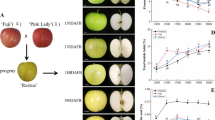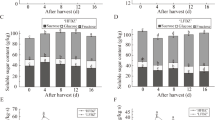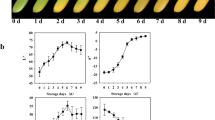Abstract
Fragaria pentaphylla, one of several wild strawberry species, produces white or red fruits. The white fruits have a stronger aroma than the red. In this study, solid-phase microextraction was used in combination with gas chromatography–mass spectrometry to compare volatiles during fruit development and maturation from the two fruit types of F. pentaphylla and the cultivated F. × ananassa. A total of 38 volatile compounds were identified in F. × ananassa, while 61 and 53 volatile compounds were identified in the white and red fruits of F. pentaphylla, respectively. The predominant volatiles in white ripe fruits of F. pentaphylla were 3(2H)-furanone 4-methoxy-2,5 methyl (24.71%), butanoic acid, 2-methyl, methyl ester (10.43%), trans-2-hexenal (9.23%). The main volatiles in red ripe fruits of F. pentaphylla were 2-hexenal (21.23%), 1-hexanol (13.29%) and 2-hexen-1-ol acetate (13.00%). While the main volatiles in ripe fruits of F. × ananassa were butanoic acid, ethyl ester (25.80%), 2-hexenal (23.47%) and butanoic acid, 2-methyl (10.09%). In addition, cyclopropane propyl was first found in the white fruits of wild F. pentaphylla at high levels (4.83%). As the intense aroma of the white fruits of F. pentaphylla is characteristic of high 3(2H)-furanone 4-methoxy-2,5 methyl production. RNA-seq was used for quantitative analysis of volatiles-related gene expression. Integrative analysis of GC–MS data and RNA-seq data from fruits of F. pentaphylla indicated that reduction of sugar in red fruits of F. pentaphylla might lead to a relatively lower DMF and higher aldehydes and alcohols compared with that in white fruits.





Similar content being viewed by others
Abbreviations
- DMF:
-
3(2H)-Furanone 4-methoxy-2,5 methyl
- DHF:
-
2,5-Dimethyl-4-hydroxy-3(2H)-furanone
- LOX:
-
Lipoxygenase
- ADH:
-
Alcohol dehydrogenase
- AAT:
-
Alcohol acyl transferases
- UFGT:
-
Flavonoid-3-O-glucosyltransferase
- F1,6P:
-
Fructose 1,6-diphosphate
- 3-PGA:
-
3-Phosphoglycerate
- PEP:
-
Phosphoenolpyruvic acid
- ShikA:
-
Shikimate
- Phe:
-
Phenylalanine
- Tyr:
-
Tyrosine
- Glc:
-
Glucose
- Pg:
-
Pelargonidin
- Pg3glc:
-
3-O-β-Glucopyranosides of pelargonidin
- Cy:
-
Cyanin
- Cy3glc:
-
3-O-β-Glucopyranosides of cyanidin
- RI:
-
Retention indices
- ID:
-
Identification method
- SPME–GC/MS:
-
Solid phase microextraction and gas chromatography–mass spectrometry
References
Hancock JF (1999) Strawberries. CAB International, Oxford
Negri AS, Allegra D, Simoni L, Rusconi F, Tonelli C, Espen L, Galbiati M (2015) Comparative analysis of fruit aroma patterns in the domesticated wild strawberries “Profumatadi Tortona” (F. moschata) and “Reginadelle Valli” (F. vesca). Front. Plant Sci 6(56):1–13
Ulrich D, Olbricht K (2013) Diversity of volatile patterns in sixteen Fragaria vesca L. accessions in comparison to cultivars of Fragaria × ananassa. J Appl Bot Food Qual 86:37–46
Ulrich D, Olbricht K (2014) Diversity of metabolite patterns and sensory characters in wild and cultivated strawberries. J Berry Res 4:11–17
Menager I, Jost M, Aubert C (2004) Changes in physicochemical characteristics and volatile constituents of strawberry (Cv. Cigaline) during maturation. J Agric Food Chem 52:1248–1254
Bood KG, Zabetakis I (2002) The biosynthesis of strawberry flavor (II): biosynthetic and molecular biology studies. J Food Sci 67(1):2–8
Forney CF (2001) Horticultural and other factors affecting aroma volatile composition of small fruit. Horttechnology 11:529–538
Azodanlau R, Darbellay C, Luisier JL, Villettaz JC, Amado R (2003) Quality assessment of strawberries (Fragaria species). J Agric Food Chem 51:715–721
Azodanlau R, Darbellay C, Luisier JL, Villettaz JC, Amado R (2004) Changes in flavour and texture during the ripening of strawberries. Eur Food Res Technol 218:167–172
Larsen M, Poll L (1992) Odour thresholds of some important aroma compounds in strawberries. Z Lebensm Unters FA 195:120–123
Schieberle P, Hofmann T (1997) Evaluation of the character impact odorants in fresh strawberry juice by quantitative measurements after sensory studies on model mixtures. J Agric Food Chem 45:227–232
Pyysalo T, Honkanen E, Hirvi T (1979) Volatiles of wild strawberries, Fragaria vesca L., compared to those of cultivated berries, Fragaria ananassa cv. Senga Sengana. J Agric Food Chem 27:19–22
Ulrich D, Komes D, Olbricht K, Hoberg E (2007) Diversity of aroma patterns in wild and cultivated Fragaria accessions. Genet Resour Crop Evol 54:1185–1196
Risser G, Navatel JC (1997) Phenologic stages of strawberry plant. In strawberry: plant and varieties. Ctifl, Paris
Cheng H, Chen JL, Li X, Pan JX, Xue SJ, Liu DH, Ye XQ (2015) Differentiation of the volatile profiles of Chinese bayberry cultivars during storage by HS–SPME–GC/MS combined with principal component analysis. Postharvest Biol Technol 100:59–72
Mortazavi A, Williams BA, McCue K, Schaeffer L, Wold B (2008) Mapping and quantifying mammalian transcriptomes by RNA-Seq. Nat Methods 5(7):621–628
Anders S, Huber W (2010) Differential expression analysis for sequence count data. Genome Biol. doi:10.1186/gb-2010-11-10-r106
Love MI, Huber W, Anders S (2014) Moderated estimation of fold change and dispersion for RNA-seq data with DESeq 2. Genome Biol 15:550–570
Schwab W, Davidovich-Rikanati R, Lewinsohn E (2008) Biosynthesis of plant-derived flavor compounds. Plant J 54:712–732
Ulrich D, Hoberg E, Rapp A, Kecke S (1997) Analysis of strawberry flavour discrimination of aroma types by quantification of volatile compounds. Z Lebensm Unters FA 205:218–223
Latrasse A (1991) Fruits III. In: Maarse H (ed) Volatile compounds in food and beverages. Marcel Dekker, Inc., New York, USA
Farine JP, Le Quere JL, Duffy J, Everaerts C, Brossut R (1994) Male sex pheromone of cockroach Eurycotis floridana (Walker) (Blattidae, Polyzosteriinae): role and composition of tergites 2 and 8 secretions. J Chem Ecol 20:2291–2306
Slaughter JC (1999) The naturally occurring furanones: formation and function from pheromone to food. Biol Rev 74:259–276
Roscher R, Bringmann G, Schreier P, Schwab W (1998) Radiotracer studies on the formation of 2,5-dimethyl-4-hydroxy-3(2H)-furanone in detached ripening strawberry fruits. J Agric Food Chem 46:1488–1493
Sasaki M, Nunomura N, Matsudo T (1991) Biosynthesis of 4-hydroxy-2(or5)-ethyl-5(or 2)-methyl-3(2H)-furanone by yeasts. J Agric Food Chem 39:934–938
Hauck T, Hubner Y, Bruhlmann F, Schwab W (2003) Alternative pathway for the formation of 4,5-dihydroxy-2,3-pentanedione, the proposed precursor of 4-hydroxy-5-methyl-3(2H)-furanone as well as autoinducer-2, and its detection as natural constituent of tomato fruit. BBA 1623:109–119
Petroni K, Tonelli C (2011) Recent advances on the regulation of anthocyanin synthesis in reproductive organs. Plant Sci 181(3):219–229
Feussner I, Wasternack C (2002) The lipoxygenase pathway. Annu Rev Plant Biol 53:275–297
Olias JM, Sanz C, Rios JJ, Perez AG (1995) Substrate specificity of alcohol acyltransferase from strawberry and banana fruit. In: Rouseff RL, Leahy MM (eds) Fruit flavors: biogenesis, characterization and authentication. American Chemical Society, Washington, DC, USA
Poll L, Lewis MJ (1986) Volatile components of elderberry juice. Lebensm Wiss Technol 19:258–262
Matsui K (2006) Green leaf volatiles: hydroperoxide lyase pathway of oxylipin metabolism. Curr Opin Plant Biol 9:274–280
Hamilton-Kemp TR, Archbold DD, Collins RW, Yu KS (2003) Emission patterns of wound volatile compounds following injury of ripe strawberry fruit. J Sci Food Agric 83:283–288
Feussner I, Kuhn H, Wasternack C (2001) The lipoxygenase dependent degradation of storage lipids. Trends Plant Sci 6:268–273
Fan JH, Ning K, Zeng XW, Luo YC, Wang DM, Hu JQ, Li J, Xu H, Huang JK, Wan MX, Wang WL, Zhang DJ, Shen GM, Run CL, Liao JJ, Fang L, Huang S, Jing XY, Su XQ, Wang AH, Bai LL, Hu ZM, Xu J, Li YG (2015) Genomic foundation of starch-to-lipid switch in oleaginous Chlorella spp. Plant Physiol 169:2444–2461
Gerhardt B, Fischer K, Balkenhohl TJ, Pohnert G, Kühn H, Wasternack C, Feussner L (2005) Lipoxygenase-mediated metabolism of storage lipids in germinating sunflower cotyledons and β-oxidation of (9Z,11E,13S)-13-hydroxy-octadeca-9,11-dienoic acid by the cotyledonary glyoxysomes. Planta 220:919–930
Peter JE, Ian AG (2001) Re-examining the role of the glyoxylate cycle in oil seeds. Trends Plant Sci 6(2):72–77
Acknowledgements
This work was financially supported by the National Natural Science Foundation of China (No. 31261120580).
Author information
Authors and Affiliations
Corresponding author
Ethics declarations
Conflict of interest
The authors declare that they have no conflict of interest.
Compliance with ethical requirements
This research does not contain any studies with human or animal subjects.
Electronic supplementary material
Below is the link to the electronic supplementary material.
Rights and permissions
About this article
Cite this article
Duan, W., Sun, P., Chen, L. et al. Comparative analysis of fruit volatiles and related gene expression between the wild strawberry Fragaria pentaphylla and cultivated Fragaria × ananassa . Eur Food Res Technol 244, 57–72 (2018). https://doi.org/10.1007/s00217-017-2935-x
Received:
Revised:
Accepted:
Published:
Issue Date:
DOI: https://doi.org/10.1007/s00217-017-2935-x




